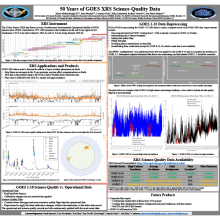50 Years of GOES XRS Science-Quality Data
James
Mothersbaugh III
NOAA National Centers for Environmental Information (NCEI) and University of Colorado Cooperative Institute for Research in Environmental Sciences (CIRES)
Poster
The X-Ray Sensor (XRS) instrument has flown on every Geostationary Operational Environmental Satellite (GOES) mission since GOES-1 launched in 1975. XRS measures solar irradiance in the X-ray region in 2 bandpasses, at 0.05-0.4 nm (short channel) and 0.1-0.8 nm (long channel). The GOES XRS data is used by the NOAA Space Weather Prediction Center (SWPC) to forecast the effects of space weather phenomena on Earth, and is also used by solar scientists to understand the statistics and dynamics of solar flares. This poster discusses science-quality data from GOES-1 through GOES-18. We are currently reprocessing the GOES-8 through -12 XRS data to create a science-quality data set. This reprocessing removes the incorrect “SWPC scaling factor” adjustment to the GOES-1 through -15 irradiances, corrects the bandpass calibration, sets data quality flags, smooths the calibrations, standardizes file formats, and fills in data gaps, all of which have already been done for the science-quality GOES-13 through -18 data sets. Additionally, we present plans for completion of the GOES-1 through -7 XRS science-quality data, and for future new XRS data products.

Poster PDF
Poster category
Solar and Interplanetary Research and Applications
Meeting homepage